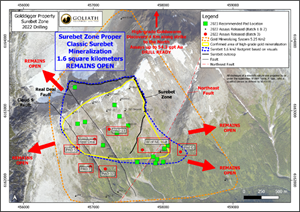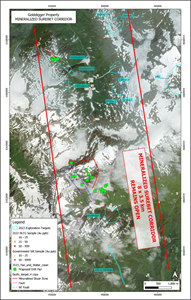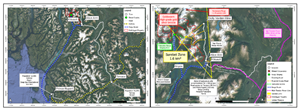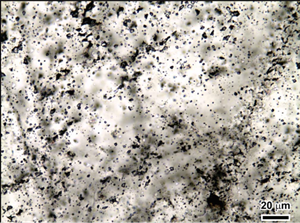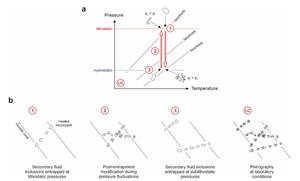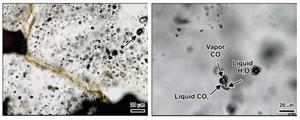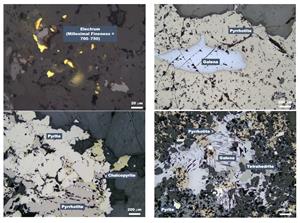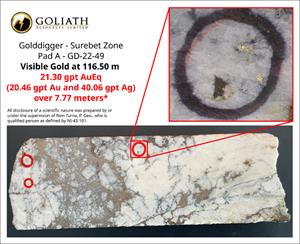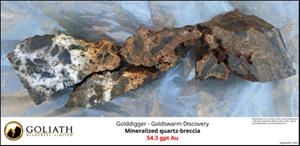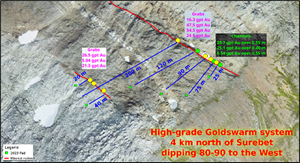PETROGRAPHY HIGHLIGHTS FROM THE COLORADO SCHOOL OF MINES REPORT:
- The fluids responsible for the high-grade gold-silver mineralization in the Surebet Zone are of magmatic origin and originate at a depth of 5-7 km below the paleo-surface.
- Geological relationships and the examination of petrographic thin sections indicate that the magmatic-hydrothermal fluids that formed the gold mineralization were derived from one of the 50-55 Ma Alice Arm intrusive complexes.
- The study identified a paragenetic sequence for the fluid pulses in the Surebet Zone comprising early quartz, followed by late quartz, followed by sulphides.
- The high CO2 content of the fluid inclusions provides unequivocal evidence that entrapment of the fluid inclusions occurred at high pressures, corresponding to a depth of 5-7 km below the paleo-surface.
- A maximum salinity of ~7 wt.% NaCl was measured in selected fluid inclusions. The true salinity is likely lower and is estimated to be ~3.5‒5 wt% NaCl. Such a salinity is consistent with the magmatic-hydrothermal fluids being derived from a porphyry intrusion (typically 2‒8 wt.% NaCl equivalent).
- The sulphide minerals formed at hydrostatic conditions through reopening of earlier formed quartz veins.
"It is great to see an explorer move a project like Golddigger along with such unique diligence," commented Dr. Quinton Hennigh, technical and geologic director of Crescat Capital, a strategic shareholder of Goliath Resources. "Not only has Goliath met the challenge of systematically drilling the Surebet discovery over the past two seasons, but it is also concurrently advancing other key aspects of the project such as metallurgy and technical study such as this. The work that the Dr. Thomas Monecke's team at the Colorado School of Mines has recently advanced, portrays a very clear genetic model that Surebet originated from magmatic derived fluids perhaps from an as yet unidentified porphyry source. This bodes well for the discovery of even more extensive mineralization in the region around Surebet and at depth."
Roger Rosmus, Founder and CEO of Goliath Resources, states: “We are very excited with additional lines of hard evidence that show there is an extensive deep seated feeder source directly related to the high-grade gold-silver mineralization seen at Surebet and likely also the source of multiple new outcrops discovered along trend for over 8 km and beyond on the Golddigger property. One could make a possible analogy to GT Gold’s initial discovery of their Saddle South Deposit, a precious metal rich vein system that eventually led them to the discovery of their Saddle North Deposit, a gold-rich copper porphyry system. All the work to date totaling only 6 months boots-on-the-ground shows we have barely begun to scratch the surface on Golddigger and are likely seeing only the tip of the iceberg. The exceptional results to date clearly demonstrate the tremendous untapped potential on our district scale 100% controlled Golddigger property encompassing 56 km of the red line as the snowpack and glacial abetment continues to expose vast areas of new outcrop annually that is certain to provide strong additional discovery potential.”
PROPERTY HIGHLIGHTS:
- The Surebet Zone being the main mineralized horizon has been confirmed in 56 drill holes over an area of 1.6 square kilometers that remains open averaging 6.31 gpt AuEq (4.45 gpt Au and 110.70 gpt Ag) over 6.88 meters* based on current modeling and drill results from 2021 and 2022.
| Interval (m)* | Au (gpt) | Ag (gpt) | Cu (%) | Pb (%) | Zn (%) | AuEq (gpt) |
| 6.88 | 4.45 | 110.7 | 0.02 | 0.57 | 0.44 | 6.31 |
- 10 out of the 56 drill holes (approx. 20 %) within in the Surebet Zone’s 1.6 square kilometer area intersected greater than 76 gram(AuEq)*meters with 5 out of the 56 drill holes (approx. 10 %) intersecting greater than 138 gram(AuEq)*meters and up to 272.8 gram(AuEq)*meters.
- Additional mineralized horizons (the “Surprise Zones”) were also intersected in drill holes above and below the main mineralized horizon which provides for excellent additional gold potential above and below the Surebet Zone that remains open.
- 89 of 92 (or 97%) widely spaced drill holes from within the 1.6 square kilometer area drilled in 2021 and 2022 intersected broad high-grade intervals of gold-silver mineralization, some containing visible gold, confirming strong gold mineralization and demonstrating the continuity of this newly discovered large gold system that remains open.
- An accompanying infographic is available at:
https://www.globenewswire.com/NewsRoom/AttachmentNg/c5e3ece3-e2f9-4203-8de7-ed79638704f3
- An accompanying infographic is available at:
- Assays confirm strong gold mineralization on the Surebet Zone that covers at least 1.6 square kilometers which remains open and is part of a much larger gold mineralized system covering at least 5.25 square km that also remains open. The assays results confirm the high-grade Surebet Zone is demarked by an area that spans from North Rubble, west-southwest 1.2 km to Pad 1 (that remains open to the North and West), southwest 750 m to Pad 11 and east 750 m to Pad A (which remains open to the East and East-Southeast; see map above).
- Goliath recently more than doubled its land package from 23,859 hectares to 54,771 hectares. The newly staked ground covers key world class geologic terrain on trend for 56 kilometers along the Red Line providing for tremendous additional discovery potential in vast areas of newly exposed outcrop due to recent permanent snow and glacial abatement. The Red Line demarks the contact between rocks of the Stuhini Group and the Hazelton Group, believed to be a key marker within ~2.5 km of which the majority of the world-class multi-million-ounce deposits in the Golden Triangle are located (see map below).
- An accompanying infographic is available at:
https://www.globenewswire.com/NewsRoom/AttachmentNg/d584e82c-a8fc-4579-ab35-33ff16e1ce78
- An accompanying infographic is available at:
- A minimum of 21 drill pads and ~ 20,000 meters drilling have been planned in preparation for the 2023 drill season focussed on expanding on the known extent of the 1.6 square kilometer Surebet Zone and the newly identified GoldenGate Feeder Zone that contains very high-grade gold mineralization and visible gold in drill core along with surface samples assaying up to 924.4 g/t Au (29.7 oz Au) and 3,023 g/t Ag (97.1 oz Ag). Prospecting and potential drilling will also take place along the newly discovered Surebet Corridor that extends for 8 km in a North-South direction covering an area of ~30 square kilometers (see maps above and below).
- An accompanying infographic is available at:
https://www.globenewswire.com/NewsRoom/AttachmentNg/3169f5fe-e364-4eef-b879-21e81ecd72e4
- An accompanying infographic is available at:
FAST FACTS:
- Golddigger Property is 54,771 hectares in size that is 100 % controlled by Goliath Resources Limited located in a world class geologic terrane and geopolitical safe jurisdiction amenable to mining in the Golden Triangle, British Columbia.
- Over 56 kilometers of the Red Line is located on the property where the majority of world class deposits have been found within 2.5 kilometers on either side of this contact point.
- Close proximity to excellent infrastructure: roads, tidewater barge landing, high tension power, accommodation for 300 crew in Kitsault with road access to Terrace and Prince Rupert.
- All new original discoveries made to date were accomplished with only 6 months in total boots on the ground. There is tremendous additional discovery potential for years to come along strike at surface and at depth as a result of recent glacial and snowpack abatement exposing vast areas of new outcrop with samples up to 924.4 g/t Au (29.7 oz Au) and 3,023 g/t Ag (97.1 oz Ag) (see sample below).
- An accompanying infographic is available at:
https://www.globenewswire.com/NewsRoom/AttachmentNg/3ef19c9f-0be2-4402-b28b-ba87298ab2ec
- An accompanying infographic is available at:
- The newly discovered Surebet Zone has been confirmed in 56 drill holes over an area of 1.6 square kilometers that has an average width and grade of 6.88 and 6.31 g/t AuEq (4.45 g/t Au & 110.7 g/t Ag) respectively with a number of holes containing visible gold; it remains open.
- 89 out of 92 widely spaced exploratory drill holes intersected mineralization at Surebet with some containing visible gold as well as multiple surprise zones above and below the main horizon. A layer cake of gold zones stacked up from near surface to depth with a remarkable 97% hit rate.
- Excellent metallurgy with 98.2 % recovery at a 150 micron crush, of which 38.1 % is free gold using simple gravity and flotation (no mercury or arsenic present – clean ore); no cyanide required.
- The Surebet Zone dips at ~40 degrees likely amiable to simple low-cost underground mining using gravity methods.
- Highly specialized experienced exploration and project generation team with a proven track record of discovery.
- The 2023 program will drill test additional new discoveries as well as expand on the Surebet Zone and focus on its high-grade feeder source at depth (the “Golden Gate”), with ~20,000 meters of targeted drilling. No historic work has been recorded on Surebet or surrounding area (see map above).
- The Surebet Zone is in an excellent location in close proximity to the communities of Alice Arm and Kitsault situated on tide water with direct barge access to Prince Rupert (190 kilometers via the Observatory inlet/Portland inlet). The town of Kitsault is accessible by road (190 kilometers from Terrace, 300 kilometers from Prince Rupert) and has a barge landing, dock, and infrastructure capable of housing at least 300 people, including high-tension power. Additional infrastructure in the are include the Dolly Varden Silver Mine Road (only 8 kilometers to the East of the Surebet discovery) with direct road access to Alice Arm barge landing (18 kilometers to the south of the Surebet discovery) and high-tension power (25 kilometers to the East of Surebet discovery). The city of Terrace (population 16,000) provides access to railway, major highways, and airport with supplies (food, fuel, lumber, etc.), while the town of Prince Rupert (population 12,000) is located on the coast and houses an international container seaport also with direct access to railway and an airport with supplies (food, fuel, lumber, etc. - see maps below).
- An accompanying infographic is available at:
https://www.globenewswire.com/NewsRoom/AttachmentNg/3b38a0b8-86ad-4f35-a0a4-88d441f47e7a
- An accompanying infographic is available at:
NEWLY DISCOVERED EXTENSIVE MINERALIZED SUREBET CORRIDOR – REMAINS OPEN
- Bulk Leach Extractable Gold (BLEG) and stream sediment sampling undertaken during the 2022 field season has identified the new north-south striking mineralized Surebet Corridor extending for 8 kilometers by 3.5 kilometers from the Ace In The Hole target area to the Goldswarm discovery, including from south to north the new Ace In The Hole target area, the new Humdinger target area (located across the valley to the south of the Surebet Extension zone), the Extension Zone, the Surebet zone, the new Sunrise target area (located to the east of Goldswarm) and the Goldswarm discovery (see map above).
- BLEG samples collected from streams assayed up to 42.74 ppb Au on the new Sunrise target area and up to 42.92 ppb Au on the new Humdinger target Area.
- The geologic team has identified a series of targets within the catchments of the streams for follow-up prospecting and mapping in 2023 in preparation for drilling.
TORONTO, Feb. 02, 2023 (GLOBE NEWSWIRE) -- Goliath Resources Limited (TSX-V: GOT) (OTCQB: GOTRF) (FSE: B4IF) (the “Company” or “Goliath”) is pleased to report initial results from the petrographic study undertaken in collaboration with the Colorado School of Mines, which confirms an extensive porphyry feeder source at depth for the gold-silver mineralising fluids at Surebet. The fluids responsible for the gold mineralization in the Surebet Zone are of magmatic origin and originate at a depth of 5-7 km. Geological relationships and the examination of petrographic thin sections indicate that the magmatic-hydrothermal fluids that formed the gold mineralization were derived from one of the 50-55 Ma Alice Arm intrusive complexes. One of these intrusive complexes hosts the Kitsault porphyry Mo deposit located 25 km to the South of the Surebet Zone.
The paragenetic sequence of fluid pulses in the main Surebet zone is as follows:
- Early vein quartz was formed at lithostatic conditions at >5‒6 km below paleosurface within host rocks that were affected by a contact metamorphic overprint.
- As the wall rocks cooled, throughgoing fracture networks were established allowing a drop in pressure from lithostatic to hydrostatic conditions. Small amounts of quartz formed magmatic-hydrothermal fluids escaping from the lithostatic into the hydrostatic realm.
- As larger structures were established focusing fluid flow, sulfide formation occurred within these zones of enhanced permeability.
Early quartz
The fluid inclusion inventory of the early quartz includes inclusions that show textural evidence for post-entrapment modification (Fig. 1 below), indicating that many fluid inclusions hosted in the early quartz were affected by pressure changes after their formation. In addition to the inclusions affected by post-entrapment modification, the early quartz is crosscut by abundant unmodified secondary fluid inclusions that have formed later in the evolution of the hydrothermal system.
An accompanying infographic is available at: https://www.globenewswire.com/NewsRoom/AttachmentNg/f6345a6b-5920-47fb-953c-91ebedca007f
Fig 1 above: Photomicrograph of secondary fluid inclusions in Q1. The quartz is host to myriads of healed microfractures defined by inclusions that are typically <5 µm in size. Many of the inclusions show decrepitation textures and inclusions with variable phase proportions. Sample D780278.
The fluid inclusion signature unequivocally suggests that early quartz formed at lithostatic pressures (Fig. 2 below). Lithostatic pressures in hydrothermal systems can only be established if fluids are migrating though a fracture mesh created by the fluids without interconnectivity to the surface. This is common in higher temperature magmatic-hydrothermal systems where rocks behave ductilely at temperatures exceeding 350‒400 °C as well as hydrothermal systems that have formed at considerable depth. Post-entrapment modification occurred as fluid inclusions were not strong enough to withstand the pressure differentials that occurred when the inclusions trapped at lithostatic conditions were decompressed to hydrostatic conditions, or if pressure fluctuations occurred between both pressure regimes (Fig. 2 a. & b. below). The inclusions in the early quartz that have not been affected by post-entrapment modification must have formed at hydrostatic conditions after formation and emplacement of the early quartz and were never subjected to higher pressures.
An accompanying infographic is available at: https://www.globenewswire.com/NewsRoom/AttachmentNg/fbfd2c91-90d3-4d75-9307-e666135c7ccb
Fig. 2 above: Diagram showing how the fluid inclusion petrography of the early vein quartz at Golddigger was formed in different pressure regimes. a. Pressure-temperature diagram showing the conditions at which fluid inclusion assemblages in the veins are entrapped or observed. Early quartz contains secondary fluid inclusions entrapped at lithostatic conditions (1). Post-entrapment modification of the fluid inclusions occurs during pressure fluctuations between lithostatic and hydrostatic conditions (2), as the fluid inclusions are not strong enough to withstand the pressure differentials from entrapment followed by a pressure drop (pi>pc) or entrapment followed by pressure increases (pc>pi). Secondary fluid inclusion assemblages are entrapped at hydrostatic conditions (3). Study of the fluid inclusion petrography occurs at laboratory conditions (LC). b. Petrographic characteristics of fluid inclusion assemblages entrapped at different pressure and temperature conditions. Early quartz contains secondary fluid inclusions along healed microcracks (1). The early formed fluid inclusions are affected by post-entrapment modification during pressure fluctuations (2). New secondary fluid inclusion assemblages are also formed at this stage and modified during subsequent pressure changes. Late secondary fluid inclusions are entrapped at hydrostatic pressures (3). At laboratory conditions (LC), a complicated integrated history of different fluid inclusion assemblages formed at different pressure and temperature conditions through time can be observed. Inclusions rich in CO2 can develop double bubbles at room temperature or show double bubbles upon cooling. Fluid inclusion assemblages that show consistent volumetric proportions among the various phases within individual inclusions must have been entrapped at hydrostatic pressures and never have been subjected to lithostatic conditions. LC = laboratory conditions; pc = confining pressure; pi = internal pressure.
Late quartz
The fluid inclusions found in the late quartz have not been affected by post-entrapment (Fig. 3 below). Virtually all secondary inclusions show the same phenomena of a double bubble forming at temperatures below room temperature, confirming the CO2-rich nature of the hydrothermal fluids. The highest temperature secondary inclusions yield homogenization temperatures as high as 350‒365 ⁰C. The homogenization behavior of these inclusions not affected by post-entrapment modification suggests that these fluids have a near-critical density. During heating, some of the inclusions homogenize to the liquid while others homogenize to the vapor. Critical fluids are known to be particularly effective for metal transport.
An accompanying infographic is available at: https://www.globenewswire.com/NewsRoom/AttachmentNg/e62ee946-ec4e-4165-a296-b348b6eada94
Fig 3 above: Photomicrograph of secondary fluid inclusions hosted in late quartz. The inclusion inventory of the quartz has not been affected by post-entrapment modification. The image was taken within the freezing stage at a temperature of -7 °C. At this low temperature, in this photomicrograph double bubbles can be faintly observed in the inclusions (arrow), which is indicative of a high CO2 content. Sample D780278.
The high CO2 content of the fluid inclusions provides unequivocal evidence that entrapment of the fluid inclusions occurred at high pressures. CO2 solubility in hydrothermal fluids depends strongly on pressure at fixed temperature. Phase relationships in the H2O-NaCl-CO2 system suggest that single-phase fluids of high CO2 content (>7‒10 mol%) only exist at pressures exceeding 500 to 600 bar at a temperature of ~350 ⁰C. Since the inclusions homogenizing at these temperatures were entrapped under hydrostatic conditions, this means that the veins at Golddigger formed at >5‒6 km below paleosurface.
A maximum salinity of ~7 wt.% NaCl was measured in selected fluid inclusions. The true salinity is likely lower as a considerable amount of clathrate is formed in the inclusions upon freezing, which results in an additional depression of the freezing point. A reasonable estimate would be ~3.5‒5 wt% NaCl. Such a salinity is consistent with the magmatic-hydrothermal fluids being derived from a porphyry intrusion (typically 2‒8 wt.% NaCl equivalent).
Precious and Base Metals
The sulphides crosscut the two earlier quartz generations. Based on the fluid inclusion evidence presented above, the sulphide minerals and the mineralization formed at hydrostatic conditions through reopening of the earlier formed quartz veins. The dominant sulphide minerals identified are pyrrhotite, sphalerite, galena, and chalcopyrite. Semiquantitative analyses on the scanning electron microscope on sample D7553c4 yielded Fe atom % contents of 7.67 to 8.46 (n=5) for the sphalerite, which is dark red in color in thin section. These comparably low Fe values suggest that the fluids forming the sphalerite were of intermediate-sulfidation state and likely not wall-rock equilibrated at the temperature of sphalerite formation. Tetrahedrite is present in many of the samples and contains up to 15 wt.% Ag. This phase may be a significant host to silver at Golddigger. Native gold is fairly abundant in the investigated samples (Fig 4. and 5. below).
An accompanying infographic is available at: https://www.globenewswire.com/NewsRoom/AttachmentNg/4b0002ac-1686-413c-8153-70455610a00c
Fig 4 above: Sulfide and ore mineral textures in samples from Golddigger. a. Native gold. Sample 36-204-2. Au = native gold (electrum). b. Galena inclusion in pyrrhotite. Sample 36-204-2. c. Pyrite, chalcopyrite, and pyrrhotite in a quartz vein. Sample 36-204-1. d. Intergrowth of galena, sphalerite, and tetrahedrite. Sample 46-138-1.
An accompanying infographic is available at: https://www.globenewswire.com/NewsRoom/AttachmentNg/ccceb04e-2e6f-42b5-b9fd-1bf9afe67842
Fig 5: Visible gold in sample from hole GD-22-49 collared from Pad A in the Extensions zone.
Goldswarm
The high-grade Goldswarm quartz-sulphide-breccia located 4 km along strike to the North of the Surebet Zone is situated within the Hazelton sediments at a similar elevation to the outcropping Surebet Zone at North Rubble. During the 2022 field season Goliath’s crew together with an independent geologist (PhD, P.Geo) confirmed compelling evidence that Goldswarm is directly related to Surebet and is believed to be part of the same extensive mineralizing gold system, including similar geologic setting, mineralization, textures, structures and geochemistry. The Company believes that the deep-rooted magmatic origin for the fluids confirmed through the work done by the Colorado School of Mines together with textural, structural, geochemical and mineralogical similarities between Surebet and Goldswarm, are strong evidence that the mineralization observed at Surebet and Goldswarm is part of the same district scale mineralizing event.
An accompanying infographic is available at: https://www.globenewswire.com/NewsRoom/AttachmentNg/9efdcd18-c837-4945-8e51-ffab8ea7bbd3
The Goldswarm Zone extends for 450 meters by 150 meters and is characterized by a series of high-grade quartz veins, stockwork and breccia domains that are variably mineralized with pyrite, chalcopyrite and galena hosted in a series of sedimentary units consisting of interlayered mudstone, siltstone, and sandstone similar to those found to host Surebet. The main mineralized horizon consists of a brecciated, partially sheared quartz vein that is steeply dipping 80 to 90 degrees to the West-Southwest. Channel samples assayed up to 29.70 gpt Au over 0.55 meters and 25.1 gpt Au over 0.40 meters and grab samples assayed up to up to 54.3 gpt, 47.5 gpt Au, 26.5 gpt Au and 24.5 gpt. Goliath plans to drill test the high-grade Goldswarm discovery from 6 drill pads with a maiden program in 2023 (see map below).
An accompanying infographic is available at: https://www.globenewswire.com/NewsRoom/AttachmentNg/6534fb38-48a4-4899-8834-1ecea59bba6a
Golddigger Property
The Golddigger Property is 100 % controlled covering an area of 54,771 hectares and is in the world class geological setting of the Eskay Rift within the Golden Triangle of British Columbia and within 2 kilometers of the ‘Red Line’ that is host to multiple world class deposits. The Surebet Zone is in an excellent location in close proximity to the communities of Alice Arm and Kitsault situated on tide water with direct barge access to Prince Rupert (190 kilometers via the Observatory inlet/Portland inlet). The town of Kitsault is accessible by road (190 kilometers from Terrace, 300 kilometers from Prince Rupert) and has a barge landing, dock, and infrastructure capable of housing at least 300 people, including high-tension power. Additional infrastructure in the are include the Dolly Varden Silver Mine Road (only 8 kilometers to the East of the Surebet discovery) with direct road access to Alice Arm barge landing (18 kilometers to the south of the Surebet discovery) and high-tension power (25 kilometers to the East of Surebet discovery). The city of Terrace (population 16,000) provides access to railway, major highways, and airport with supplies (food, fuel, lumber, etc.), while the town of Prince Rupert (population 12,000) is located on the coast and houses an international container seaport also with direct access to railway and an airport with supplies (food, fuel, lumber, etc.- see maps above).
Surebet is characterized by a series of NW-SE trending structures that occur within a package of Hazelton Group sediments underlain by Hazelton volcanics and are within a few kilometers of the Red Line. All 24 diamond drill holes completed in 2021 intersected significant intervals of Au-Ag polymetallic mineralization over 1 km of strike, 1.1 km down-dip and 600 meters of vertical relief. Drill hole GD-21-03* intersected 6.37 gpt AuEq (4.46 gpt Au and 122.13 gpt Ag) over 35.72 meters and drill hole GD-21-05* intersected 12.6 gpt AuEq (8.06 gpt Au and 313.66 gpt Ag) over 6.38 meters. The average grade and width from all 24 holes* assayed 6.29 gpt AuEq (4.35 gpt Au and 104.94 gpt Ag) over 5.87 meters, respectively.
LiDAR imagery, drone imagery, and field observations have identified several additional paralleling structures within a 4 square-kilometers area. Geochemical analyses have confirmed high-grade gold-silver polymetallic mineralization within these structures. The steeply dipping Real Deal and Cloud 9 structures, as well as the off-shoot structures from the East Extension Zone, display similar mineralization, geochemistry, and textures to the Surebet Zone. Geologic observations at surface and within drill core show structural strain concentrating in the Surebet Zone along its shallower-dipping geometry. Real Deal and Cloud 9 are believed to be en-echelon structures that connect with Surebet at depth. The mineralized Surebet Zone remains open in all directions.
Qualified Person
Rein Turna P. Geo is the qualified person as defined by National Instrument 43-101, for Goliath Resource Limited projects, and supervised the preparation of, and has reviewed and approved, the technical information in this release.
Other
Oriented HQ-diameter or NQ-diameter diamond drill core from the drill campaign is placed in core boxes by the drill crew contracted by the Company. Core boxes are transported by helicopter to the staging area, and then transported by truck to the core shack. The core is then re-orientated, meterage blocks are checked, meter marks are labelled, Recovery and RQD measurements taken, and primary bedding and secondary structural features including veins, dykes, cleavage, and shears are noted and measured. The core is then described and transcribed in MX DepositTM. Drill holes were planned using Leapfrog GeoTM and QGISTM software and data from the 2017-2021 exploration campaigns. Drill core containing quartz breccia, stockwork, veining and/or sulphide(s), or notable alteration are sampled in lengths of 0.5 to 1.5 meters. Core samples are cut lengthwise in half, one-half remains in the box and the other half is inserted in a clean plastic bag with a sample tag. Standards, blanks and duplicates were added in the sample stream at a rate of 10%. All samples are transported in rice bags sealed with numbered security tags. A transport company takes them from the core shack to the ALS labs facilities in North Vancouver. ALS is either certified to ISO 9001:2008 or accredited to ISO 17025:2005 in all of its locations. At ALS samples were processed, dried, crushed, and pulverized before analysis using the ME-MS61 and Au-SCR21 methods. For the ME-MS61 method, a prepared sample is digested with perchloric, nitric, hydrofluoric and hydrochloric acids. The residue is topped up with dilute hydrochloric acid and analyzed by inductively coupled plasma atomic emission spectrometry. Overlimits were re-analyzed using the ME-OG62 and Ag-GRA21 methods (gravimetric finish). For Au-SCR21 a large volume of sample is needed (typically 1-3kg). The sample is crushed and screened (usually to -106 micron) to separate coarse gold particles from fine material. After screening, two aliquots of the fine fraction are analysed using the traditional fire assay method. The fine fraction is expected to be reasonably homogenous and well represented by the duplicate analyses. The entire coarse fraction is assayed to determine the contribution of the coarse gold.
The reader is cautioned that grab samples are spot samples which are typically, but not exclusively, constrained to mineralization. Grab samples are selective in nature and collected to determine the presence or absence of mineralization and are not intended to be representative of the material sampled.
About Goliath Resources Limited
Goliath Resources Limited is an explorer of precious metals projects in the prolific Golden Triangle of northwestern British Columbia and Abitibi Greenstone Belt of Quebec. All of its projects are in world class geological settings and geopolitical safe jurisdictions amenable to mining in Canada.
For more information please contact:
Goliath Resources Limited
Mr. Roger Rosmus
Founder and CEO
Tel: +1-416-488-2887
roger@goliathresources.com
www.goliathresourcesltd.com
*Widths are reported in drill core lengths and the true widths are approximately 80-90% and AuEq metal values are calculated using: Au 1644.08 USD/oz, Ag 19.23 USD/oz, Cu 3.47 USD/lbs, Pb 1870.50 USD/ton and Zn 2882.50 USD/ton on October 28, 2022. There is potential for economic recovery of gold, silver, copper, lead, and zinc from these occurrences based on other mining and exploration projects in the same Golden Triangle Mining Camp where Goliath’s project is located such as the Homestake Ridge Gold Project (Auryn Resources Technical Report, Updated Mineral Resource Estimate and Preliminary Economic Assessment on the Homestake Ridge Gold Project, prepared by Minefill Services Inc. (Bothell, Washington), dated May 29, 2020. Here, AuEq values were calculated using 3-year running averages for metal price, and included provisions for metallurgical recoveries, treatment charges, refining costs, and transportation. Recoveries for Gold were 85.5%, Silver at 74.6%, Copper at 74.6% and Lead at 45.3%. It will be assumed that Zinc can be recovered with the Copper at the same recovery rate of 74.6%. The quoted reference of metallurgical recoveries is not from Goliath’s Golddigger Project, Surebet Zone mineralization, and there is no guarantee that such recoveries will ever be achieved, unless detailed metallurgical work such as in a Feasibility Study can be eventually completed on the Golddigger Project.
Neither the TSX Venture Exchange nor its Regulation Services Provider (as that term is defined in the policies of the TSX Venture Exchange), nor the OTCQB Venture Market accepts responsibility for the adequacy or accuracy of this release.
Certain statements contained in this press release constitute forward-looking information. These statements relate to future events or future performance. The use of any of the words "could", "intend", "expect", "believe", "will", "projected", "estimated" and similar expressions and statements relating to matters that are not historical facts are intended to identify forward-looking information and are based on Goliath’s current belief or assumptions as to the outcome and timing of such future events. Actual future results may differ materially. In particular, this release contains forward-looking information relating to, among other things, the ability of Company to complete the financings and its ability to build value for its shareholders as it develops its mining properties. Various assumptions or factors are typically applied in drawing conclusions or making the forecasts or projections set out in forward-looking information. Those assumptions and factors are based on information currently available to Goliath. Although such statements are based on management's reasonable assumptions, there can be no assurance that the proposed transactions will occur, or that if the proposed transactions do occur, will be completed on the terms described above.
The forward-looking information contained in this release is made as of the date hereof and Goliath is not obligated to update or revise any forward-looking information, whether as a result of new information, future events or otherwise, except as required by applicable securities laws. Because of the risks, uncertainties and assumptions contained herein, investors should not place undue reliance on forward-looking information. The foregoing statements expressly qualify any forward-looking information contained herein.
This announcement does not constitute an offer, invitation, or recommendation to subscribe for or purchase any securities and neither this announcement nor anything contained in it shall form the basis of any contract or commitment. In particular, this announcement does not constitute an offer to sell, or a solicitation of an offer to buy, securities in the United States, or in any other jurisdiction in which such an offer would be illegal.
The securities referred to herein have not been and will not be will not be registered under the United States Securities Act of 1933, as amended (the “U.S. Securities Act”), or any state securities laws and may not be offered or sold within the United States or to or for the account or benefit of a U.S. person (as defined in Regulation S under the U.S. Securities Act) unless registered under the U.S. Securities Act and applicable state securities laws or an exemption from such registration is available.
NOT FOR DISSEMINATION IN THE UNITED STATES OR FOR DISTRIBUTION TO U.S. NEWSWIRE SERVICES AND DOES NOT CONSTITUTE AN OFFER OF THE SECURITIES DESCRIBED HEREIN.







